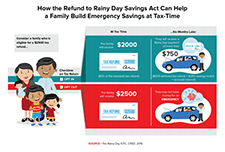This paper examines households’ financial fragility by looking at their capacity to come up with $2,000 in 30 days. Using data from the 2009 TNS Global Economic Crisis survey, the respondents who report being certain or probably not able to cope with an ordinary financial shock of this size amount to nearly half of Americans. We examine the coping methods people use to deal with shocks. While savings is used most often, relying on family and friends, using formal and alternative credit, increasing work hours, and selling items are also used frequently to deal with emergencies, especially for some subgroups. Finally, the paper compares the levels of financial fragility and methods of coping among eight industrialized countries.
Weathering Volatility: Big Data on the Financial Ups and Downs of U.S. Individuals


